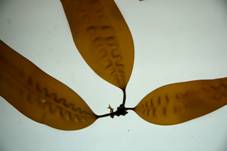Significant progresses have been made in the international cooperation project between the ChineseAcademy of Sciences and the RussianAcademy of Sciences (Nr. 21 project in 2008). The project entitled with ?°Phylogeny study of the economic seaweeds along the coasts of the Northwest Pacific?± was led by Dr. S.J. Pang based at Marine Biological Culture Collection Centre (MBCCC, URL: www.mbccc.ac.cn) in the Institute of Oceanology, ChineseAcademy of Sciences (IOCAS) in Qingdao.
Researchers in Dr. Pang?ˉs group used two wild populations of Saccharina japonica isolated from Dalnegorsk (44?? N) and Vladivostok (43?? N) from Russia and hybridized them with six major farmed cultivars and wild population isolated in China (25-36?? N). They used mono-crossing of haploid gametophyte clone lines and were successful in all six trials. The hybrids are now cultured both in tanks of MBCCC and on long lines in the open sea.
The success of these hybridization experiments demonstrated that researchers at MBCCC have made important progresses in the research of breeding this important farmed seaweed.

Photo shows the first filial hybrids cultured in the tank system at MBCCC (Pang et al., unpublished material).
Significant progresses have been made in the international cooperation project between the ChineseAcademy of Sciences and the RussianAcademy of Sciences (Nr. 21 project in 2008). The project entitled with ?°Phylogeny study of the economic seaweeds along the coasts of the Northwest Pacific?± was led by Dr. S.J. Pang based at Marine Biological Culture Collection Centre (MBCCC, URL: www.mbccc.ac.cn) in the Institute of Oceanology, ChineseAcademy of Sciences (IOCAS) in Qingdao.
Researchers in Dr. Pang?ˉs group used two wild populations of Saccharina japonica isolated from Dalnegorsk (44?? N) and Vladivostok (43?? N) from Russia and hybridized them with six major farmed cultivars and wild population isolated in China (25-36?? N). They used mono-crossing of haploid gametophyte clone lines and were successful in all six trials. The hybrids are now cultured both in tanks of MBCCC and on long lines in the open sea.
The success of these hybridization experiments demonstrated that researchers at MBCCC have made important progresses in the research of breeding this important farmed seaweed.

